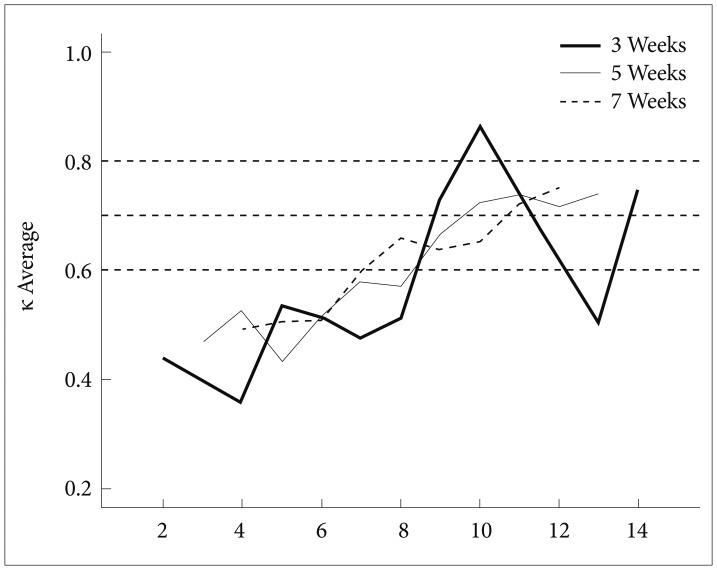Clin Endosc.
2013 Nov;46(6):633-636.
Learning Curve of Capsule Endoscopy
- Affiliations
-
- 1Department of Internal Medicine, Dongguk University College of Medicine, Goyang, Korea.
- 2Department of Statistics, Dongguk University, Seoul, Korea.
- 3Department of Internal Medicine, The Catholic University of Korea College of Medicine, Seoul, Korea. choim@catholic.ac.kr
- 4Department of Internal Medicine, University of Ulsan College of Medicine, Seoul, Korea.
- 5Department of Internal Medicine, Inje University College of Medicine, Busan, Korea.
- 6Department of Internal Medicine, Yonsei University College of Medicine, Seoul, Korea.
- 7Department of Internal Medicine, Ewha Womans University School of Medicine, Seoul, Korea.
- 8Department of Internal Medicine, Chung-Ang University College of Medicine, Seoul, Korea.
- 9Department of Internal Medicine, Yeungnam University College of Medicine, Daegu, Korea.
- 10Department of Internal Medicine, Soonchunhyang University College of Medicine, Seoul, Korea.
- 11Department of Internal Medicine, Korea University College of Medicine, Seoul, Korea.
Abstract
- BACKGROUND/AIMS
Capsule endoscopy (CE) has become an important tool for the diagnosis of small bowel disease. Although CE does not require the skill of endoscope insertion, the images should be interpreted by a person with experience in assessing images of the gastrointestinal mucosa. This investigation aimed to document the number of cases needed by trainees to gain the necessary experience for CE competency.
METHODS
Fifteen cases were distributed to 12 trainees with no previous experience of CE during their gastroenterology training as clinical fellows. Twelve trainees and an expert were asked to read CE images from one patient each week for 15 weeks. The diagnosis was reported using five categories (no abnormalities detected, small bowel erosion or ulcer, small bowel tumor, Crohn disease, and active small bowel bleeding with no identifiable source). We then examined, using the kappa coefficient, how the degree of mean agreements between the trainees and the expert changed as the training progressed each week.
RESULTS
The agreement rate of CE diagnosis increased as the frequencies of interpretation increased. Most of the mean kappa coefficients were >0.60 and >0.80 after week 9 and 11, respectively.
CONCLUSIONS
Experience with approximately 10 cases of CE is appropriate for trainees to attain CE competency.
Keyword
MeSH Terms
Figure
Reference
-
1. Mishkin DS, Chuttani R, Croffie J, et al. ASGE Technology Status Evaluation Report: wireless capsule endoscopy. Gastrointest Endosc. 2006; 63:539–545. PMID: 16564850.
Article2. American Association for the Study of Liver Diseases. American College of Gastroenterology. American Gastroenterological Association (AGA) Institute. American Society for Gastrointestinal Endoscopy. The gastroenterology core curriculum, third edition. Gastroenterology. 2007; 132:2012–2018. PMID: 17484892.3. Faigel DO, Baron TH, Adler DG, et al. ASGE guideline: guidelines for credentialing and granting privileges for capsule endoscopy. Gastrointest Endosc. 2005; 61:503–505. PMID: 15812400.
Article4. Varela Lema L, Ruano-Ravina A. Effectiveness and safety of capsule endoscopy in the diagnosis of small bowel diseases. J Clin Gastroenterol. 2008; 42:466–471. PMID: 18277887.
Article5. Rey JF, Ladas S, Alhassani A, Kuznetsov K. ESGE Guidelines Committee. European Society of Gastrointestinal Endoscopy (ESGE). Video capsule endoscopy: update to guidelines (May 2006). Endoscopy. 2006; 38:1047–1053. PMID: 17058174.6. Gut Image Study Group. Lim YJ, Moon JS, et al. Korean Society of Gastrointestinal Endoscopy (KSGE) guidelines for credentialing and granting previleges for capsule endoscopy. Korean J Gastrointest Endosc. 2008; 37:393–402.7. Viazis N, Sgouros S, Papaxoinis K, et al. Bowel preparation increases the diagnostic yield of capsule endoscopy: a prospective, randomized, controlled study. Gastrointest Endosc. 2004; 60:534–538. PMID: 15472674.
Article8. Dai N, Gubler C, Hengstler P, Meyenberger C, Bauerfeind P. Improved capsule endoscopy after bowel preparation. Gastrointest Endosc. 2005; 61:28–31. PMID: 15672052.
Article9. Niv Y, Niv G. Capsule endoscopy: role of bowel preparation in successful visualization. Scand J Gastroenterol. 2004; 39:1005–1009. PMID: 15513342.
Article10. Ben-Soussan E, Savoye G, Antonietti M, Ramirez S, Ducrotté P, Lerebours E. Is a 2-liter PEG preparation useful before capsule endoscopy? J Clin Gastroenterol. 2005; 39:381–384. PMID: 15815205.
Article11. Fleiss JL. Measuring nominal scale agreement among many raters. Psychol Bull. 1971; 76:378–382.
Article12. Cohen J. A coefficient of agreement for nominal scales. Educ Psychol Meas. 1960; 20:37–46.
Article13. Selby W. Complete small-bowel transit in patients undergoing capsule endoscopy: determining factors and improvement with metoclopramide. Gastrointest Endosc. 2005; 61:80–85. PMID: 15672061.
Article14. Korman LY, Delvaux M, Gay G, et al. Capsule endoscopy structured terminology (CEST): proposal of a standardized and structured terminology for reporting capsule endoscopy procedures. Endoscopy. 2005; 37:951–959. PMID: 16189767.
Article15. Ahmad NA, Iqbal N, Joyce A. Clinical impact of capsule endoscopy on management of gastrointestinal disorders. Clin Gastroenterol Hepatol. 2008; 6:433–437. PMID: 18325843.
Article16. van Tuyl SA, van Noorden JT, Stolk MF, Kuipers EJ. Clinical consequences of videocapsule endoscopy in GI bleeding and Crohn's disease. Gastrointest Endosc. 2007; 66:1164–1170. PMID: 17904134.
Article17. Mergener K, Ponchon T, Gralnek I, et al. Literature review and recommendations for clinical application of small-bowel capsule endoscopy, based on a panel discussion by international experts. Consensus statements for small-bowel capsule endoscopy, 2006/2007. Endoscopy. 2007; 39:895–909. PMID: 17968807.18. Maiden L, Thjodleifsson B, Theodors A, Gonzalez J, Bjarnason I. A quantitative analysis of NSAID-induced small bowel pathology by capsule enteroscopy. Gastroenterology. 2005; 128:1172–1178. PMID: 15887101.
Article


